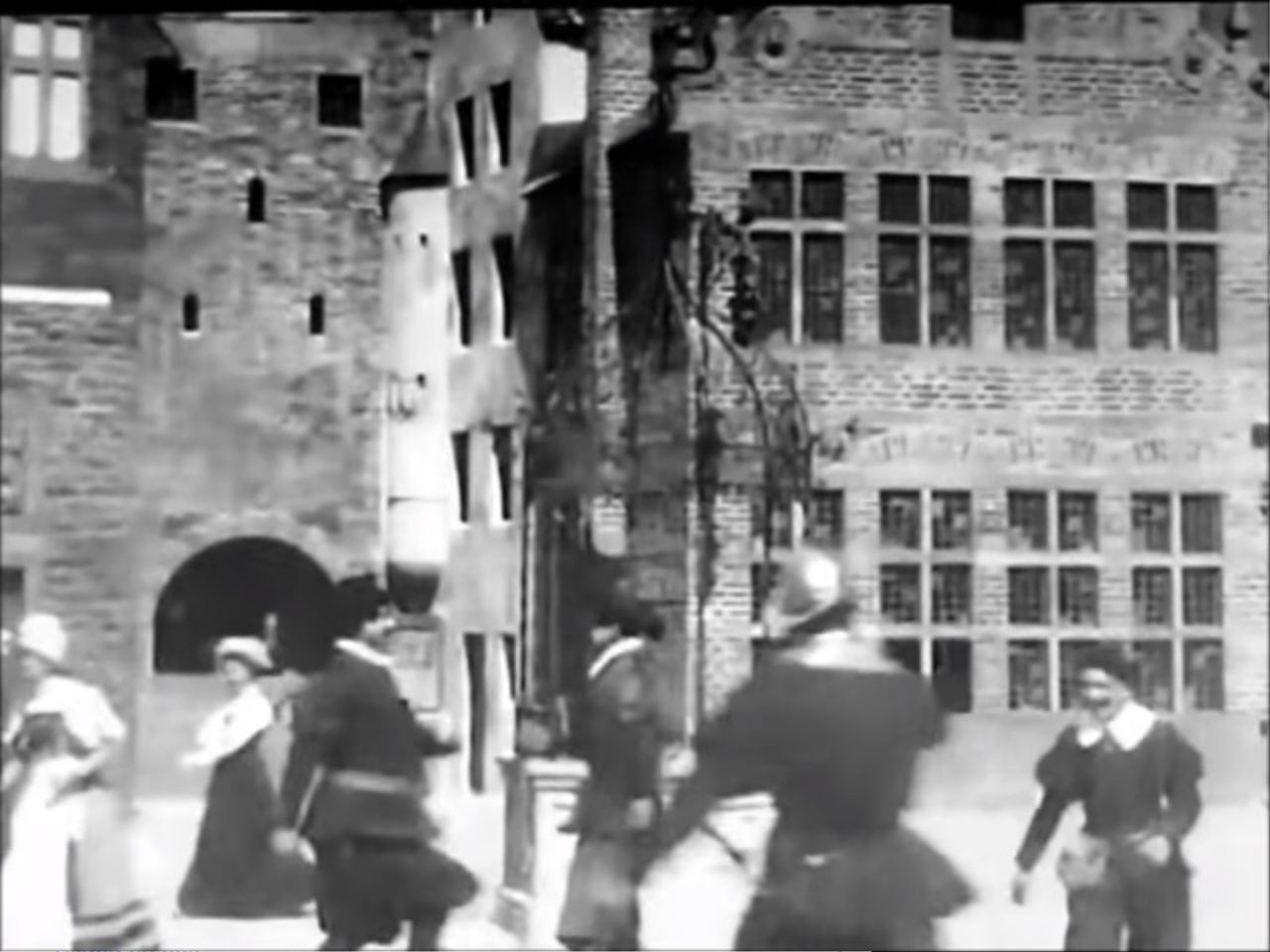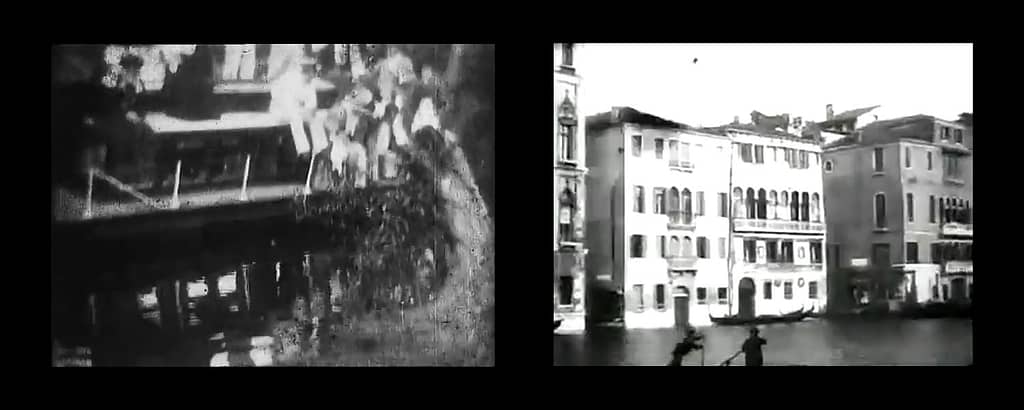
To deepen my knowledge of the silent era on the European continent, I created the European Silent Cinema Project. I review two European silent films each year starting in 1895 and ending in 1930. Visit the project’s main page for a comprehensive list of films and reviews.
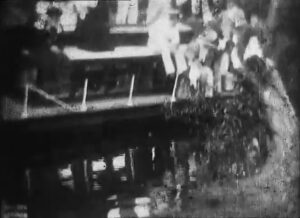
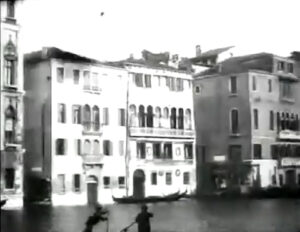
Film #1: Scene on the River Thames (Up the River)
Director: Robert W. Paul
Country: United Kingdom
Film #2: Panorama of the Grand Canal from Boat (Panorama du grand Canal pris d’un bateau)
Director: Alexandre Promio
Country: France
Years of innovations had led to several projected film screenings in North America and Europe in the year 1895; however, the first public exhibitions of films for a paying audience in Europe occurred late in the year. The Lumiere brothers’ famed program of ten films, including their Workers Leaving The Lumiere Factory, was in fact projected for an audience in the Grand Cafe on the very the last weekend of 1895.
That same year, small groups of competing individuals experimented with new cameras and projectors; 1896 saw a rapid increase in film production as capable cameras and projectors not only were more readily available but had already proven to be a commercial success. Inventors and technicians who lacked business acumen would themselves fall behind such illuminary filmmakers and showmen like the Lumiere brothers, George Melies, Alice Guy-Blache, and the Pathe brothers.
A British electrician and instrument maker named Robert W. Paul’s trajectory as a film producer exemplifies the blossoming of film production in 1896. Paul first got into filmmaking in 1895 when he bought one of Edison’s Kinetoscopes in order to make copies of the machine. Since Edison had not patented the Kinetoscope in Great Britain, Paul was able to make a few dozen Kinetoscope copies. Because Edison tightly controlled his films, Paul would have to create his own to show. Along with the help of Birt Acres, a British photographer, Paul designed the Paul-Acres camera and shot a dozen or so films in 1895 to run on his revised Kinetoscopes.
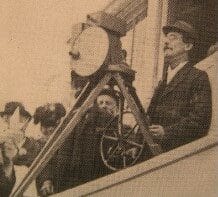
Birt Acres with the Paul-Acres camera
After the dozen short films he shot with Birt Acres in the summer of 1895, Paul did not make another film the rest of the year. Birt Acres went on to other projects and Paul turned to work on creating a film projector he would call The Theaterograph. Whether or not Paul saw the writing on the wall for the limited peepshow device is hard to tell but Paul did not see any substantial financial incentive to continue creating films in 1895.
By the time Paul completed The Theatrograph and presented it to the public in February of 1896, numerous successfully projected film programs had proved the financial potential of making one’s own films and charging others to see them. Paul reverse-engineered his newly invented Theatropgraph to make his own camera. He started shooting films again in April 1896, filming over seventy short actualities and short fiction films that year.
While in the years to come Paul would be at the forefront of incorporating in-camera special effects, his 1896 films are tightly framed and static, rarely lasting over a minute. Many Robert W. Paul films are quite playful in nature, showing such entertaining scenes as a drunk husband coming home to a displeased wife at 2 a.m., a three-man costume relay race, or a Spanish bullfight. Alongside this energetic output of early films, Paul also tried his hand at a few shorts with more cohesive narrative structures.
Scene on the River Thames
For instance, Scene on the River Thames centers around the rescue of a drowning child. The short film begins with a small boat floating down the river. At first, it seems we might just watch the boat drift down the river and enjoy the scenic view of the River Thames for the duration of the film. Instead, a woman drops her child into the river after carelessly dangling him overboard. The frame becomes crowded as people on shore dart in front of the camera on the river shore to see what happened. A man jumps in the river to save the child. The hero is pulled out by a life preserver as the short film concludes.
While the film is ambitious in capturing a high-stakes rescue in under a minute, the poor framing of the film confuses the viewer. Only by watching it closely or repeating the film can you notice what the woman is dangling overboard. The daring rescue is blocked from the camera and the audience by an onslaught of anxious onlookers.
We cannot enjoy the heroics of the man who jumps into the river to save the baby if we can only witness him jumping into the water before he is out of view. We don’t even get a clear shot of the rescued man and child when they are pulled to shore! Early films like this allowed Paul to experiment with what worked and what didn’t. Perhaps the limitations of these early films pushed Paul to implement in-camera special effects and other edits before the turn of the 20th century.
While Robert W. Paul’s 1896 output shows the success that one individual could reach with a camera, a projector, and a market, the Lumiere brothers’ production team of numerous camera personnel foreshadowed the assembly line production of future film studios. The Lumiere brothers did not wait to promote their cinematograph after its initial success, putting together a team of cameramen and the occasional camerawoman. Numerous Lumiere camera operators were sent around the world to both shoot and exhibit films. The first film screenings and films shot in countries such as Egypt, Brazil, and Mexico were achieved on visits from the Lumiere brothers’ camera operators starting in 1896.
While the Lumiere brothers sought to spread their brand as they ran up against Thomas Edison on the world stage, they also sent out their camera operators abroad to add films of exotic and unique locations to their catalog. In 1896 alone camera operators filmed such sites as the Swiss Alps, the busy streets of New York City and the Venice canals, and such events as a royal wedding in Italy, the coronation of Tsar Nicolas II in Russia, and military drills in Mexico. Throughout the rest of the 1890s, the Lumiere brothers would further their reach, sending camera operators to nearly every corner of the Earth.
Panorama of the Grand Canal from Boat
While many of the films shot by Lumiere camera operators looked rather similar, some films stand out because of the particular way they were shot. One such short film is Panorama of the Grand Canal taken from a Boat. The film was shot in Venice by Alexander Promio, one of the most well-traveled of the Lumiere cameramen who visited America, Italy, Spain, and Russia all in 1896. The film is very much an actuality, capturing everyday scenes as if the camera was not there; however, what separates this film from its contemporaries is the movement of the camera. Promio had placed the camera in a gondola to shoot this scene of the canal.
The film’s perspective from a moving gondola gives the audience the viewpoint of someone traveling in the gondola down the canal. The camera is remarkably steady-handed as we float down the river. We don’t just see buildings lining the water but various boats passing us by and people walking along the shore. The camera is framed to give us a clear and concentrated view. Even though it is a simple achievement, Promio’s use of natural movement to liven the film shows the medium of film’s potential to differentiate itself from the mediums of vaudeville and theater that film heavily borrowed from. While the technology to pan and tilt the camera was on the horizon, a simple trip in a canal foreshadowed the camera’s increased mobility in the future.
Both Promio’s innovative actualities and Paul’s inventive narrative films show filmmakers’ experiments with varying visions of a nascent art form in the wake of film projection’s early commercial success. While such achievements as structured narratives and camera movements might seem mundane and commonplace to us modern viewers, these would inspire and influence numerous filmmakers to try new ideas in the ensuing years, long before a consistent film grammar was formed.
Previous—1895: European Film Gets an Audience

